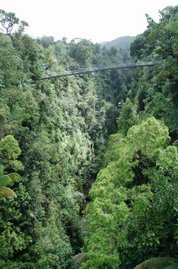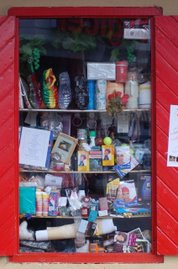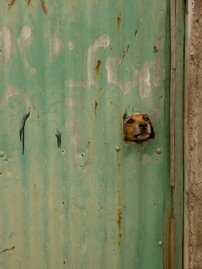 We drove back and forth a couple of times and finally decided to ask a couple of young boys hanging out by the bus stop on the main road. “Just here”, they immediately shouted, and pointed towards a small gravel road, leading inland. It all made sense, but as we are experienced and not too easily fooled we knew better. Wouldn’t rely on just one opinion. A couple of hundred meters inland, we met another group of boys. They all confirmed: We were on the right track. “But it is quite far”, they added, with big Dominican smiles on their faces, and made a detailed description on how to get there. The road got narrower, steeper, but no sight of the big tree or bay rum factory they mentioned. After a while what is left of the road made a sharp turn, started going downhill and all of a sudden we found ourselves back on the main road again. Going back down again, towards Grand Bay, we drove pass what now had turned into a large group of kids, all laughing and giggling.
We drove back and forth a couple of times and finally decided to ask a couple of young boys hanging out by the bus stop on the main road. “Just here”, they immediately shouted, and pointed towards a small gravel road, leading inland. It all made sense, but as we are experienced and not too easily fooled we knew better. Wouldn’t rely on just one opinion. A couple of hundred meters inland, we met another group of boys. They all confirmed: We were on the right track. “But it is quite far”, they added, with big Dominican smiles on their faces, and made a detailed description on how to get there. The road got narrower, steeper, but no sight of the big tree or bay rum factory they mentioned. After a while what is left of the road made a sharp turn, started going downhill and all of a sudden we found ourselves back on the main road again. Going back down again, towards Grand Bay, we drove pass what now had turned into a large group of kids, all laughing and giggling.Instead, we stopped and asked a couple of young women, on their way to Mass, no risk of them lying, Sunday and everything, but by the time we found the Riviére Blanche, or White River, where the trail starts, we were hungry, decided to have picnic already, then threw some pebbles in the river and decided to return soon, now that we knew where it is.
Several months passed, but this Sunday we easily make it back to the entrance, turn where the signs to the Pichelin-Delices trail stands, just south of Delices, long before the unfortunate bus stop, and leave the car on the “security parking”, are excused from the five US fee and set off, determined to make it this time.
To get from the parking to the actual waterfall, you have to make five river crossings, and although the hike is not extremely difficult, it is best to avoid it when it is raining, as dangerous flashfloods can appear surprisingly fast and unexpected. With a 25 pound almost two years old on your back, it is definitely not recommended.
But today the sun is shining and the water never gets more than knee-high, sometimes up to the thighs, in any of the crossings.
 And there is nothing wrong with the trail. Once you find it after each crossing it is easy. The trouble is finding it. And also knowing exactly when and where to cross the river. There are absolutely no signs and I am absolutely convinced the local, most likely self-appointed, so called guides are eager to keep it that way.
And there is nothing wrong with the trail. Once you find it after each crossing it is easy. The trouble is finding it. And also knowing exactly when and where to cross the river. There are absolutely no signs and I am absolutely convinced the local, most likely self-appointed, so called guides are eager to keep it that way.Half way through the first river crossing a man conveniently appears, offers us his guide services. And the truth is, we probably wouldn’t have made it all the way to the waterfall without him. At least, it would have taken several hours longer, and plenty of discussions on how dangerous or not dangerous this or that crossing or rock-climbing is, especially with a baby on the back.
With our guide we move along fast, cross the river five times, walk the trails on each side and finally, after the last and deepest crossing, do some basic climbing over a few rocks.
 Here we can already get glimpses of the waterfall and it is impressing. It is not the tallest in Dominica, with its 100 feet it makes the forth or fifth, after the Middleham Falls 200 ft, River Jack Falls 150 ft, also found on the Pichelin-Delices trail, and the Trafalgar Falls with its approximately 120 ft. But it is definitely one of the most impressing.
Here we can already get glimpses of the waterfall and it is impressing. It is not the tallest in Dominica, with its 100 feet it makes the forth or fifth, after the Middleham Falls 200 ft, River Jack Falls 150 ft, also found on the Pichelin-Delices trail, and the Trafalgar Falls with its approximately 120 ft. But it is definitely one of the most impressing.Below the falls there is a huge pool, and as the water cascades into it, you get quite a shower, blowing strongly in your face when you stand on the shore, wetting you almost completely. It is like a super-version of the Emerald Pool. We stay for a while to absorb the beauty and strength, but decide to have our lunch by one of the many turquoise-white pools we passed on our way up. The water in the Victoria Falls and the White River, all come from the Boiling Lake in the mountains high above, the reason for its milky mineral rich water.
The way back is easier, we know our way and it is easier to slide down the rocks to get back to the last crossing, at least for me who don’t carry a baby on my back. Beware of little feet that shouldn’t get stuck between rocks!
After three crossings, about halfway back, we find a perfect enough pool, with a small sandy beach full of pebbles, say good bye and thank you to our guide and sit down on the soft and warm rocks, contemplating the river, listening to the birds, having lunch.
Later in the afternoon, on our way back to the car and just before the last crossing, we swim in the bigger pool, the one just where the trail starts. It is definitely refreshing, almost cool, but extremely relaxing. To let the stream bring you down-river looking up at the scattered clouds and trees hanging over, makes you forget about everything but the moment.

We will soon be back, if only to have a swim, make a couple of crossings and sit by the river. And now that we know the way, it wouldn’t be that hard to make it all the way to the falls on our own either.
 How to get there: From Roseau, head for Grand Bay (that is south to Loubiere where you turn left to cross the southern tip of the island) and then continue up north along the Atlantic coast, on a wonderful and beautiful, breathtaking and sufficiently winding road, up and down the hills abruptly descending into the roaring ocean. Then, just before (!) the small village of Delices, turn left when you see the sign for the Pichelin-Delices trail. It is about an hour’s drive from Roseau. Finally, it is a short drive downhill until the road ends, where there is a “security parking”, obviously on private land. This time, a small reception center was under construction, the men working there promised us we would be able to get cool Kubuli next time.
How to get there: From Roseau, head for Grand Bay (that is south to Loubiere where you turn left to cross the southern tip of the island) and then continue up north along the Atlantic coast, on a wonderful and beautiful, breathtaking and sufficiently winding road, up and down the hills abruptly descending into the roaring ocean. Then, just before (!) the small village of Delices, turn left when you see the sign for the Pichelin-Delices trail. It is about an hour’s drive from Roseau. Finally, it is a short drive downhill until the road ends, where there is a “security parking”, obviously on private land. This time, a small reception center was under construction, the men working there promised us we would be able to get cool Kubuli next time.If it is your first time, I would really recommend a guide. The trail itself isn’t hard, but it is hard to find it after each crossing and it is also hard to know exactly when and where to cross. Two or three times the trail also splits in two, and it is not always obvious which to take.
Four or five small signs along the trail would do it, but that would, of course, mean no more need for guides. I can understand the low priority given to this…


















